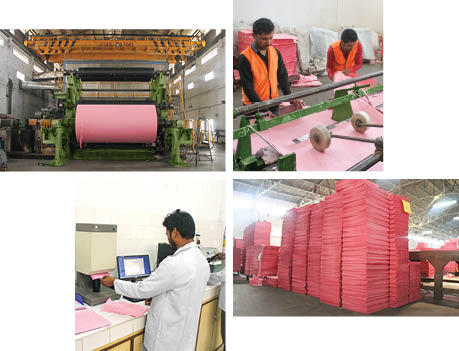Ruchira Papers Limited, with a capacity of over 1,00,000 TPA at its Kala Amb, Himachal Pradesh facility, has steadily transitioned from being primarily a writing and printing paper manufacturer to a significant player in the white and specialty packaging paper segment. The mill makes white packaging paper in GSM ranges of 60–180, from agro-based virgin fiber. Combining sustainability, strength, and aesthetics, the white packaging paper serves diverse applications. In an exclusive interview with Paper Mart, Director of Ruchira Papers Limited, Ms. Ruchica shared that the company is investing in automation, process control, and enhancing its pulping efficiency, while also developing lighter GSM variants to improve cost-effectiveness and elevate customer experience.

Paper Mart: Could you begin by giving us an overview of your packaging paper and board operations – including your production capacity, facility locations, and manufacturing setup?
Ruchica: In recent years, the packaging segment has emerged as one of the most dynamic and fast-growing domains in the paper industry, and at Ruchira Papers Limited, we have been not just responding to this demand – we’ve been anticipating it.
Our journey into packaging began with a clear understanding that the future lies in functionality, sustainability, and adaptability. With a production capacity of over 1,00,000 TPA and a robust presence in North India from our facility in Kala Amb, Himachal Pradesh, we have steadily transitioned from being primarily a writing and printing paper manufacturer to a significant player in the white and specialty packaging paper segment.
Our integrated manufacturing setup is equipped with modern pulping lines, energy-efficient processes, and stringent quality controls – all tailored to meet the evolving needs of packaging converters and consumer-facing brands alike.

Balancing performance and cost-efficiency has always been a challenge. We tackle this through backward integration, localized sourcing networks, and by continuously benchmarking our processes against best-in-class operations.
PM: Please walk us through your current product portfolio. What grades, GSM ranges, and end-use applications do you cater to, and are there any specialty packaging paper and board products you offer?
RU: Our packaging paper portfolio caters to a wide spectrum of end uses, encompassing both white and kraft packaging grades. We offer high-quality white packaging paper across various GSMs ranging from 60 to 180, suitable for food packaging, pharma, hygiene products, retail packaging, and value-added converting applications.
These grades are designed to meet demanding parameters of printability, hygiene compliance, and surface finish. On the kraft paper side, we offer high RCT kraft paper suitable for corrugation, carton manufacturing, and protective packaging for industrial and retail use cases. Our focus on white packaging paper made from agro-based virgin fiber gives us a sustainable edge, offering strength and aesthetics in equal measure.
Watch: In Pursuit of Lesser Water Footprint
PM: Which are your key domestic and international markets? How has your market footprint evolved in the past few years?

RU: Over the last few years, our domestic footprint has grown considerably. While North India remains our stronghold, we now have a firm presence across Western and Central India.
The trust we have earned has been driven by product reliability, strong technical support, and the ability to customize grades as per client requirements. With the white packaging segment gaining momentum, we are proud to offer an Indian alternative that is both high-performance and environmentally responsible.
PM: Sustainability is becoming a cornerstone of packaging. What steps have you taken to integrate environmentally responsible practices into your manufacturing and sourcing?
RU: Sustainability is not just a buzzword for us; it is embedded in our DNA. Long before Environmental, Social, and Governance (ESG) principles became a boardroom mandate, we had committed ourselves to a circular approach.
Our white packaging paper is made from agri-residue such as wheat straw, sugarcane bagasse, and rice husk – agricultural byproducts that would otherwise go to waste or worse, be burnt. By converting them into high-strength, aesthetically superior paper, we reduce carbon emissions, support rural livelihoods, and lower dependency on wood-based pulp.
PM: How has demand for packaging paper and board evolved post-COVID and amid growing e-commerce and FMCG consumption? Which segments are currently driving the most growth for you?

RU: Post-COVID, the surge in e-commerce, hygiene awareness, and sustainable retail packaging has created significant opportunities for white packaging grades. There is a clear shift from plastic-based packaging to paper-based alternatives, especially in food delivery, pharmaceutical, and personal care sectors. Brands are now more conscious of both packaging performance and its environmental footprint, and this is where our white grades are seeing increasing traction.
PM: What are some of the most significant technological upgrades or process improvements you’ve made recently in your mills to enhance quality, reduce waste, or optimize energy usage?
RU: To keep pace, we’ve invested in key technology upgrades over the past two years – including automation in sheet formation, process control systems to reduce variability, and enhancements in pulping efficiency to improve yield from agro-residue.

Our packaging paper portfolio caters to a wide spectrum of end uses, encompassing both white and kraft packaging grades. These grades are designed to meet demanding parameters of printability, hygiene compliance, and surface finish.
PM: Are you seeing a shift in customer preference toward higher-strength or lightweight packaging paper and board variants? How are you balancing performance with cost-efficiency in product development?
RU: Our R&D team is actively working on lighter GSM variants with better stiffness and surface properties, which allow for both cost-effectiveness and improved user experience – a crucial factor for our clients.
PM: What are the major challenges you currently face as a packaging paper and board manufacturer– be it raw material volatility, energy costs, logistics, or regulatory changes? How are you navigating them?
RU: Balancing performance and cost-efficiency has always been a challenge, especially in times of raw material price volatility and rising energy costs. We tackle this through backward integration, localized sourcing networks, and by continuously benchmarking our processes against best-in-class operations. Logistics, particularly for agro-residue procurement, is another challenge that we’ve addressed by building a dependable supplier base directly in farming communities – thereby ensuring both quality and consistency.
Also Read: Apollo Papers Eyes Global Market Expansion; Plans to Manufacture VTL and Paper Bag Grades
PM: Looking ahead, what’s your strategic roadmap – capacity expansion, backward integration, export push, product diversification? How do you envision your mill’s role in the global packaging paper and board value chain in the next 5 years?
RU: Looking ahead, our focus remains on staying agile and responsive to the evolving needs of the packaging industry. It is always our endeavor to meet market demands through ongoing innovation and product development. We continue to explore new categories and functional improvements that cater to emerging applications and align with sustainability goals.
With our current production capacity fully absorbed in the domestic market, we remain committed to deepening our presence and creating value within India.

There is a clear shift from plastic-based packaging to paper-based alternatives. Brands are now more conscious of both packaging performance and its environmental footprint, and this is where our white grades are seeing increasing traction.



